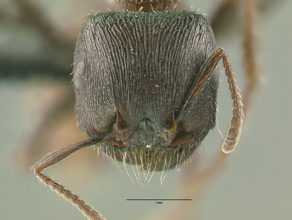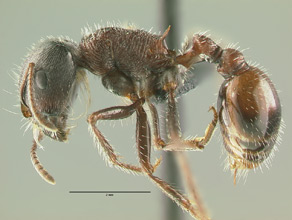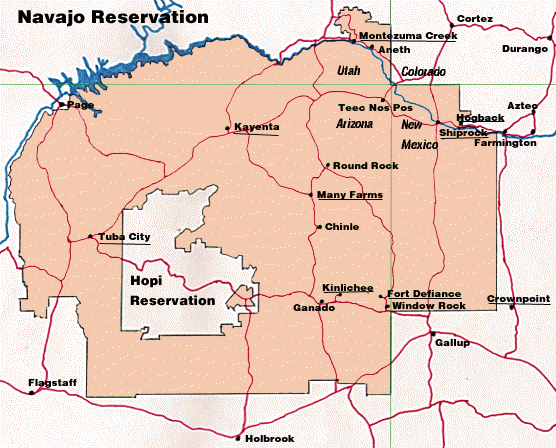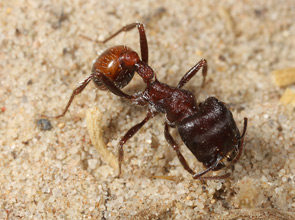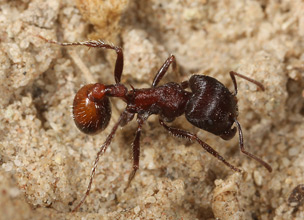- Identification
- (from Cole 1968): Workers possess a red to brownish or reddish black body which is sometimes rather concolorous but which is more likely to possess a bicolored gaster or, less frequently, one that is entirely yellow. The rugae on the head are moderately to very coarse and are widely separated. The promesonotal rugae are very coarse, very irregular and wavy, and form strong reticulations which enclose flattened, shining areas of the integument.
- Biology
-
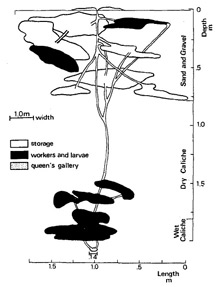 Nests of this species are marked by a flattened gravel disk, typically with a single nest opening. Pogonomyrmex rugosus nest in open desert, and are easily found due to the conspicuousness of the gravel disk and a surrounding area that is clear of all vegetation.
Nests of this species are marked by a flattened gravel disk, typically with a single nest opening. Pogonomyrmex rugosus nest in open desert, and are easily found due to the conspicuousness of the gravel disk and a surrounding area that is clear of all vegetation. - additional biology notes...
- Distribution
- Range
- United States and Mexico. Includeing Arizona, Oklahoma, Texas, Colorado, New Mexico, Utah, Nevada, California.
- Navajo Reservation Records
- Samples being processed.
- Additional Notes
- Pogonomyrmex are abundant and often conspicuous ants in arid low-latitude habitats of the Americas. Cole (1968) offered this well written general introduction to the genus:
The genus Pogonomyrmex is the preeminent group of harvesting ants in North America, where it nearly blankets the arid regions of Mexico and the western United States. As is true of other harvesting ants, the workers of this genus collect seeds for food, "harvesting" the plants in their nesting areas by snipping off the seeds with their mandibles. Husked within the nest and stored in subterranean or mound chambers, these highly nutritious seeds become the paramount food for the society, sustaining the ants even through the winter. Seeds are not their sole food, however, because the ants are scavengers as well as harvesters. Although their victims are chiefly arthropods, the workers may transport a varied array of dead booty to their nests.
The nests themselves are constructed in the soil, generally in areas fully exposed to the sun. Some are beneath stones, whereas others are surmounted by soil craters or by small to huge mounds with or without coverings of gravel. In addition, the workers of some species alter the area peripheral to the nests by clearing away the plants, felling them, bit by bit, with their powerful mandibles. Such mounds their surrounding denuded area, characteristic of the western harvester, are familiar sights to travelers in the arid West.
Although the workers of some species of Pogonomyrmex are extremely hostile and will vigorously attack and sting an invader, other species are contrastingly inoffensive and retiring.
- Nest Architecture
- The structure of the underground nest is that of a central shaft with 12 to 15 chambers radiating off in various directions. The bulk of the nest area is found within the first meter, which is also where seeds are cached. Chambers vary from 0.3 to 1.3 m in diameter and have an average height of 5mm. In the In southern New Mexico, the deepest nest chambers were within the hardpan caliche layer, which offers a distinctively moister soil than the soil horizon found just above. See Whitford et al. (1976) for additional information.
- Foraging
- Pogonomyrmex rugosus are adaptable in their daily foraging activity. In one southern New Mexico study there was no activity in May, a single afternoon peak of activity in June, and two foraging peaks (mid-morning and late afternoon) and nighttime foraging in July. These changes are attributable to adjustments made to forage at optimal temperatures (daytime shifts in timing) and in response to interspecific competition with Pogonomyrmex barbatus (nightime foraging). A later observation revealed foragers could become active during times of the year when there was seemingly no activity, provided there was an abundance of food available. A mass emergence of Grass cicadas (Beameria vanosa) in late May stimulated foraging activity in a New Mexico location. This resulted in large numbers of these insect prey being captured by the ants (Whitford 2007).
- Foragers primarily collect seeds, concentrating on perennial grasses and a select number of forb species. Insects are collected, along with seeds, whenever they are found. The number of workers that participate in foraging can vary from a few hundred to a few thousand, depending on colony size and the season.
- Trunk trails are used for foraging. These are persistent trails that begin at the nest entrance and radiate out into a colony's foraging area. Foragers will typically depart the nest following one of these trails, will follow this trail for a time, then depart from the trunk trail to begin their search for food.
- Etymology
- Morphological. L. rugosus = wrinkled


- Literature
- Cole, A. C., Jr. 1968. Pogonomyrmex harvester ants. A study of the genus in North America. University of Tennessee Press, Knoxville, Tenn.
- Emery, C. 1895. Beiträge zur Kenntniss der nordamerikanischen Ameisenfauna. (Schluss). Zoologische Jahrbücher, Abteilung für Systematik, Geographie und Biologie der Tiere. 8:257-360.
- Whitford, W. G. and G. Ettershank. 1975. Factors affecting foraging activity in Chihuahuan desert harvester ants. Environmental Entomology. 4:689-696.
- Whitford, W. G. and E. Jackson. 2007. Seed harvester ants (Pogonomyrmex rugosus) as 'pulse' predators. Journal of Arid Environments. 70:549-552.
- Whitford, W. G., P. Johnson, and J. Ramirez. 1976. Comparative ecology of the harvester ants Pogonomyrmex barbatus (F. Smith) and Pogonomyrmex rugosus (Emery). Insectes Sociaux. 23:117-132.
- A note about these publications. The literature cited here is not meant to be an exhaustive list of papers published about this species.
Page authored by David Lubertazzi and Gary Alpert
